“Who has given the wind wisdom,
Lent the air a tongue so lightsome,
Ready speech to the yard’s rowan,
And the small birds’ tender bevy?”(from All Seemed to Be Speaking, Speaking, by Johan Ludvig Runeberg, translated by C.E. Tallquist)
One of the things I like about our historical themes is that I get to learn little tidbits about various other parts of the world, or people whom I’d not heard of before, or simply new knowledge. Or at least it seems so – it’s quite possible that some of it involves things I learned, eons ago in school, and have forgotten. While I’m fairly certain I had never heard of Finnish national poet Johan Ludvig Runeberg prior to planning last weekend’s dinners, it is likely that I did know some of the history of the region. Still, when I read that he was so important to the country, yet had written all his poetry in Swedish, I found myself thinking, “why?” It took only a few minutes research to remember that Finland had been part of Sweden until 1809, and he was born in 1804, so likely grew up speaking, reading and writing Swedish. I’d forgotten that Finland then became a part of Russia, and remained so until declaring its independence in 1917. It is interesting, at least to me, that over those 206 years, the Finnish language has so completely replaced the Swedish as the regional language, relegating the latter to a minority one spoken by a mere 5% of the population. Or that while in Finnish the name for the country is Suomi while the word Finland is the Swedish name for the region.
But back to Mr. Runeberg, how wrote grand, epic poems, married a woman who was also a well-known poet, had children, and, at some point, had the opening stanzas of what is arguably his greatest work turned into the Finnish national anthem. His wife also went on to “create” a tart that he enjoyed, now called a Runeberg’s Tart, and served up every year on the man’s birthday, February 5th, nationwide. Supposedly, this tart is her personal re-creation of a nearby confectioner’s tart, and Runeberg had one every morning with his breakfast, along with a little shot of the national liqueur, punsch. We shall, of course, return to the tart, which is really more of a cupcake, but who’s to quibble with the dearly departed?
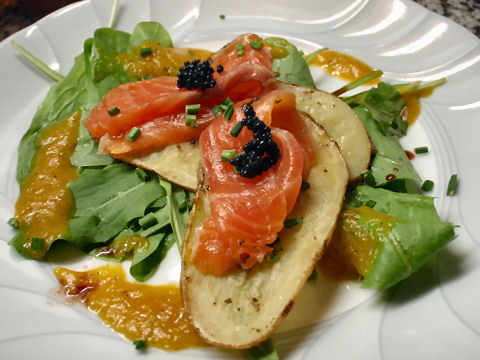
We had to start with some homemade gravlax, cured with citrus and dill, served over slices of oven roasted potatoes, a salad of local greens (radichetta), and a drizzle of roasted yellow pepper puree, olive oil and balsamic vinegar. A little dab of lumpfish caviar atop.
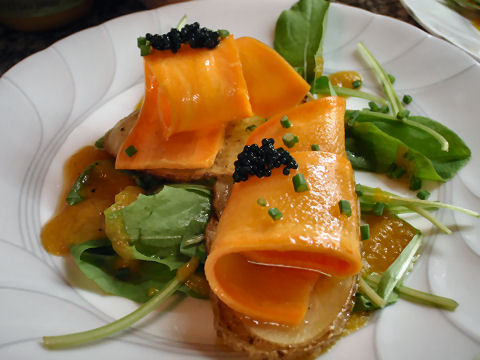
One night a vegetarian guest was attending, so I thought I’d make something similar out of carrots – the color and all that, so I cured strips of carrot the same way (though only leaving them curing for about 3 hours), then rinsed them well to get rid of excess salt and bathed them in warm olive oil, where they sat for a couple more hours. I did put the little dab of caviar on as he’d informed me that he eats eggs, though that turned out to be a faux pas on my part – apparently the ethics of eating fish eggs are different from the ethics of eating chicken eggs, since the former involves that the fish must be deceased, which, honestly to me seems more of a timing argument, since you can count on that any hen laying eggs will eventually no longer be a prodigious egg-layer and be consigned to the stewpot. Regardless, he flicked the caviar to the side and seemed to enjoy the salad – at the very least, the grav-carrots make an interesting salt-cured pickle of sorts.
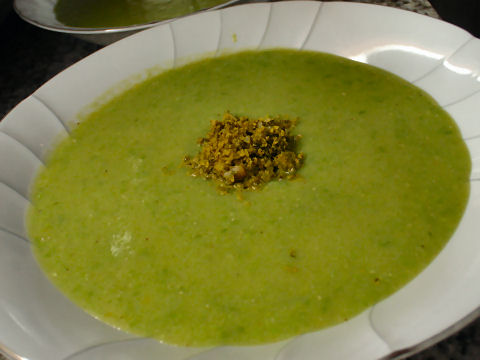
A simple fresh pea soup – the traditional being more of a dried split pea soup with ham hocks and all that good stuff, but I wanted to keep this lighter and fresher – I sauteed chopped green onions and a small amount of celery and carrot in olive oil until soft, added a diced potato for thickness, some mustard powder, allspice, salt, pepper and water. Brought it to a boil and simmered it until the potatoes were done, then added previously blanched and shocked fresh peas (you could also use frozen peas at this point) and pureed the whole mixture. I made a little sort of pesto-ish thing to go in the middle – finely ground green pumpkin seeds with lots of fresh mint, a little nutritional yeast and a dash of turmeric for color.

This is only loosely inspired by the apparently ever popular Karelian Pasty. Traditionally, it’s a rye crust filled with a savory barley or mixed grain stuffing, though more modern versions use rice or millet; then the whole thing is topped with eggbutter – a mixture of butter and hard-boiled eggs. I’ve played around with these before, in a sort of empanada form, but was much happier this time – a mix of rice flavored with sauteed shallots and mushrooms spiked with a little tarragon, fresh chili and some molasses. At the end some blackcurrants mixed in, then when cool, I filled the rye pastry rounds with the mixture and folded them as you see. No butter, no eggs, just a little olive oil over the top and into the oven to bake.
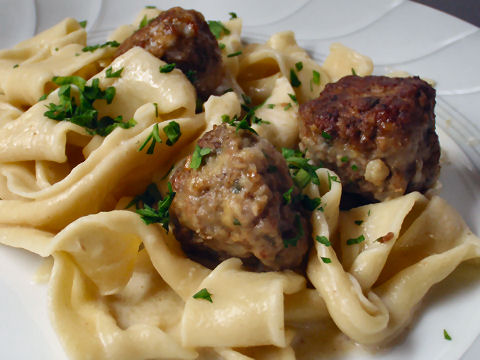
Of course, we couldn’t have a dinner like this without Finnish meatballs, or lihapullat. Perhaps not quite as famed as the Swedish ones, these are, well, as best I can tell, pretty much the same thing. The traditional way to serve them is with gravy, boiled or mashed potatoes, lingonberry jam and often, pickled cucumbers. I made the meatballs fairly traditional, but served them over homemade semolina pappardelle with the reduced gravy in which the meatballs cooked, finished with a bit of cream. The meatballs themselves you can find a zillion recipes online – they’re a mix of beef and pork (I used roast beef and bondiola, respectively, and ground them coarsely), lots of onion, Gouda cheese, white and black pepper, allspice, and bound with bread and eggs. After browning them in a little olive oil they’re popped into a pot with a beef and onion stock, cooked until done, then set aside to remain warm while I boiled down the stock to about half its volume, added some cream to finish it, and voila. For our vegetarian friend I made seitan, flavored with all the same ingredients, only reversing the order of cooking – they were simmered first in an onion broth, and then browned to order and served with the broth, again reduced and finished with a splash of cream.
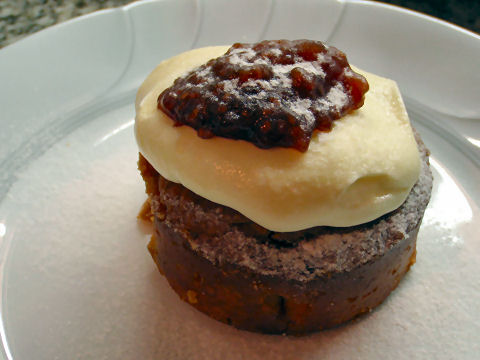
And, my version of the Runeberg’s Tart. I followed an online recipe more or less to the letter (I had no vanilla sugar so used ½ tsp of vanilla extract), and went for a look that approximates the various online photos of the dessert that I found. It’s essentially an almond cupcake topped with whipped cream (instead of the sugar icing) and raspberry jam, and after tasting one, I can understand why Johan Ludvig ate one every morning with his breakfast – I did too with the remaining ones… though with my coffee, I’m not quite up for a shot of punsch first thing in the a.m.